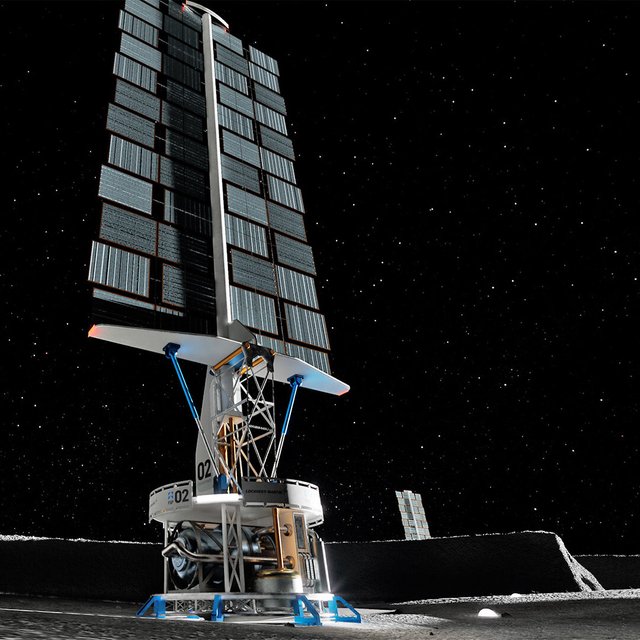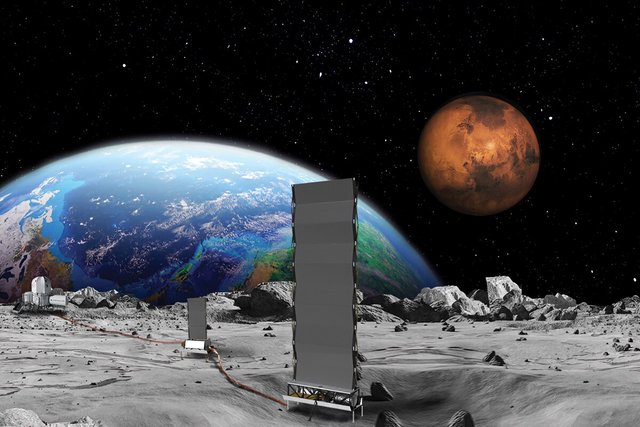NASA has an urgent mission to place a fission reactor on the Moon/La NASA tiene la misión urgente de colocar un reactor de fisión en la Luna

Source
After the end of World War II, the world was divided into two blocs: the United States and the Russian-dominated USSR. For several decades, the two powers competed in every field, from science to politics to technology. Among these challenges was the space race, which began with the USSR's launch of the first artificial satellite: Sputnik. From then on, they achieved various milestones until, in 1969, the United States successfully landed a man on the moon for the first time.
Después de terminada la segunda guerra mundial el mundo quedó dividido en dos bloques: EEUU y la URSS dominada por Rusia. Durante varias décadas las dos potencias estuvieron echándose pulsos en todos los ámbitos tanto científicos como políticos como tecnológicos. Entre todos los desafíos se encontraba la carrera espacial que dio comienzo con el lanzamiento por parte de la URSS del primer satélite artificial: el Sputnik. A partir de ahí fueron consiguiendo diversos hitos hasta que, en 1969, EEUU consigue colocar por primera vez a un hombre en la Luna.
The space race concluded in 1975 with the launch of the joint Apollo-Soyuz mission. But this phase of history ended, the USSR disintegrated, and the fierce competition ceased. At that time in history, China did not yet pose a political threat, but today's China is nothing like that and has now become a worthy rival to the United States. With these elements in mind, we are witnessing a new version of the space race, but now between China and the United States for the colonization of our satellite.
La carrera espacial concluyó en 1975 con el lanzamiento de la misión conjunta Apolo-Soyuz. Pero esta etapa de la historia terminó, la URSS se desmembró y cesó la competencia feroz. En aquel momento de la historia, China todavía no ofrecía una amenaza política, pero la China de hoy no tiene nada que ver con aquella y ahora se ha convertido en un digno rival para USA. Con estos mimbres asistimos a una nueva versión de la carrera espacial, pero ahora entre China y EEUU por la colonización de nuestro satélite.

Source
In this unique setting, China and Russia officially announced plans to jointly build a nuclear power plant on the Moon to power the International Lunar Research Station (ILRS). They aim to have it operational by 2035, with the ultimate goal of establishing a manned base at the lunar south pole around 2050, powered by nuclear reactors and other systems. China is preparing the Chang'e-8 mission for 2028, which will be the initial pillar of its stable lunar presence, and this is making the US very nervous.
En este marco incomparable, China y Rusia anunciaron oficialmente planes para construir juntos una central nuclear en la Luna para alimentar la estación lunar internacional ILRS, apuntando a tenerla operativa hacia 2035, con el objetivo final de establecer una base tripulada en el polo sur lunar alrededor de 2050, con energía proveniente de reactores nucleares y otros sistemas. China prepara la misión Chang'e-8 para 2028 que será el pilar inicial de su presencia lunar estable y esto pone muy nerviosos a los EEUU.
Fission reactors are almost essential for permanent bases, since the lunar night lasts about two weeks and solar panels cannot supply the continuous energy demands for habitats, laboratories or communications systems. There is a directive according to which the first to install a stable reactor could claim exclusive areas for research, resource extraction and geopolitical and technical control over future missions, so things are becoming urgent and they cannot rest on their laurels.
Los reactores de fisión son casi imprescindibles para bases permanentes, ya que la noche lunar dura unas dos semanas y las baterías solares no pueden abastecer las demandas energéticas continuas para hábitats, laboratorios o sistemas de comunicaciones y existe una directiva según la cual, el primero en instalar un reactor estable podría reclamar zonas exclusivas para investigación, extracción de recursos y control geopolítico y técnico sobre futuras misiones, por lo que la cosa se vuelve apremiante y no se pueden dormir en los laureles.

Source
In this scenario, under the current administration, NASA was ordered to expedite the project to have an operational nuclear reactor on the Moon by 2030. NASA's most advanced project is Fission Surface Power, initially focused on a reactor of about 40kW, although recent instructions call for a design of at least 100kW of electrical power, enough to sustain a small human habitat. NASA plans to launch a formal solicitation to conduct a 1-year demonstration on the lunar surface and operate for 9 more years.
En este escenario bajo la administración actual , NASA recibió la orden de agilizar el proyecto para tener un reactor nuclear operativo en la Luna antes de 2030. El proyecto más avanzado de la NASA es el Fission Surface Power, enfocado inicialmente en un reactor de unos 40kW, aunque las recientes instrucciones piden un diseño de al menos 100kW de potencia eléctrica, suficiente para sostener un pequeño hábitat humano. NASA planea lanzar una solicitud formal para realizar una demostración de 1 año en la superficie lunar y operar 9 años más.
Beyond the childishness of these types of challenges, there's no doubt they're a powerful catalyst for enormous technological advancement. These companies not only produce disruptive technologies and scientific discoveries. I remind you that the previous space race also produced such mundane things as the Velcro we wear on our clothes today, the Teflon coating on our pans, and the "Paper Mate" pen, which could even write upside down because it was designed to write in the absence of gravity.
Más allá de lo pueriles que resultan este tipo de desafíos no cabe duda que son un buen catalizador para avanzar enormemente en tecnología. De estas empresas no solo surgen tecnologías disruptivas y descubrimientos científicos, os recuerdo que de la anterior carrera espacial surgieron cosas tan mundanas como el velcro que hoy llevamos en nuestra ropa, el teflón que cubre nuestras sartenes o el bolígrafo "Paper mate" que podía incluso escribir boca arriba pues estaba diseñado para escribir en ausencia de gravedad.
More information/Más información
https://www.nytimes.com/2025/08/06/science/nasa-nuclear-reactor-moon.html